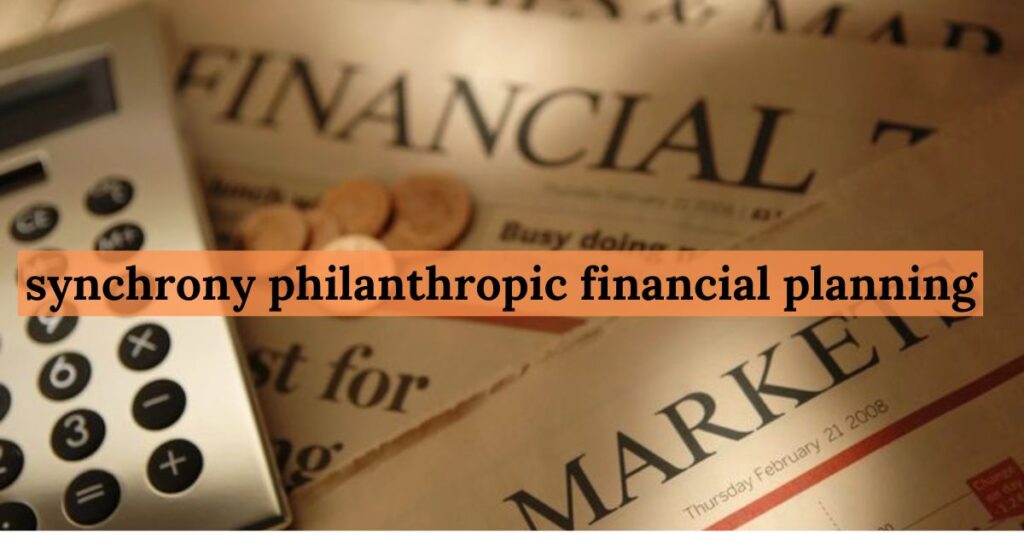In the dynamic landscape of financial strategies and social responsibility, synchrony philanthropic financial planning emerges as a powerful approach to creating lasting change. Modern philanthropists are no longer satisfied with traditional giving methods; they seek comprehensive ways to align their personal values with strategic financial decisions.
This holistic approach represents more than just charitable contributions—it’s a transformative journey of purposeful wealth management that connects individual potential with broader societal needs.
The Essence of Philanthropy in Financial Planning
Philanthropic efforts have evolved far beyond simple monetary donations. Today’s strategic approach integrates financial planning with deep-rooted social commitments, creating a sophisticated framework for meaningful giving. Individuals are increasingly recognizing that their financial resources can be powerful tools for addressing critical societal challenges, from education funding to environmental sustainability.
The modern philanthropist understands that true impact requires more than sporadic contributions. It demands a comprehensive strategy that carefully balances personal financial health with social responsibility. By thoughtfully integrating charitable donations into overall wealth management, individuals can create sustainable pathways for generating positive social change while maintaining their own financial security.
Aligning Values and Financial Goals
Personal values serve as the fundamental compass guiding philanthropic strategies. Successful philanthropists take time to deeply reflect on the causes that resonate most profoundly with their beliefs—whether it’s social justice, healthcare initiatives, or community development. This introspective process transforms charitable giving from a transactional experience to a deeply meaningful personal mission.
Mapping philanthropic aspirations requires careful consideration of individual passions and societal needs. By identifying specific areas of impact, donors can develop targeted strategies that maximize their contributions’ effectiveness. This alignment ensures that every dollar contributed represents a deliberate investment in creating meaningful societal transformation.
Conducting a Comprehensive Financial Analysis
Financial analysis forms the critical foundation of synchrony philanthropic financial planning. A thorough examination of income, expenses, assets, and liabilities provides the necessary context for developing a sustainable giving strategy. This comprehensive approach ensures that charitable commitments don’t compromise overall financial stability.
Professional wealth managers recommend creating a detailed financial profile that accounts for both short-term needs and long-term philanthropic goals. By understanding one’s complete financial landscape, individuals can identify optimal giving opportunities that align with their economic capacity and social aspirations.
Exploring Tax Optimization Strategies
Tax optimization represents a crucial dimension of strategic philanthropic planning. Sophisticated donors leverage various giving vehicles to maximize their social impact while minimizing tax liabilities. Donor-advised funds, charitable trusts, and private foundations offer nuanced approaches to creating tax-efficient giving strategies.
Understanding IRS guidelines and potential tax deductions associated with charitable contributions can significantly enhance the financial efficiency of philanthropic efforts. By working with experienced financial advisors, donors can develop sophisticated strategies that provide both social and economic benefits.
Strategic Philanthropic Giving
Strategic giving transcends traditional donation models by emphasizing purposeful, measured approaches to social investment. This method involves carefully selecting charitable organizations, evaluating their operational effectiveness, and tracking measurable outcomes. Modern philanthropists seek transparency and demonstrable impact in their charitable vehicles.
Timing and method become essential considerations in strategic philanthropy. Donors must assess whether one-time gifts, recurring contributions, or establishing dedicated charitable funds will most effectively advance their social objectives. This deliberate approach ensures that each contribution represents a meaningful step toward broader societal goals.
Establishing a Legacy through Philanthropy
Legacy planning elevates philanthropic efforts from immediate contributions to multi-generational social impact. By integrating charitable donations into estate planning, individuals can create enduring frameworks that continue supporting critical causes long after their direct involvement.
Establishing philanthropic legacies involves creating robust mechanisms like charitable trusts and foundations that can sustain social initiatives across generations. These strategic approaches not only honor an individual’s values but also inspire future generations to engage meaningfully with social challenges.
Read Also: 0969 What Network in the Philippines?
Navigating Challenges in Philanthropic Giving
Despite noble intentions, philanthropic journeys inevitably encounter challenges. Donor fatigue, complex tax regulations, and the intricate landscape of social needs can create obstacles. Successful philanthropists develop resilience by maintaining flexible strategies and staying informed about evolving social dynamics.
Proactive communication with financial advisors and continuous education about philanthropic efforts help donors navigate potential complications. By approaching challenges with adaptability and commitment, individuals can maintain momentum in their social impact journey.
Technology and Innovation in Philanthropy
Digital philanthropy has revolutionized how individuals engage with charitable giving. Online platforms, social media, and advanced reporting tools have made collaborative philanthropy more accessible and transparent than ever before. Technology enables donors to track their contributions’ real-time impact and connect directly with beneficiary communities.
Impact measurement technologies allow philanthropists to assess the effectiveness of their contributions with unprecedented precision. Advanced analytics and reporting tools provide insights that help donors refine and optimize their philanthropic strategies.
Sustainability and Future-Oriented Giving
Sustainable practices have become central to modern philanthropic approaches. Donors increasingly prioritize initiatives that address long-term societal challenges, such as renewable energy projects and community development programs. This shift reflects a growing understanding that sustainable solutions create more profound and lasting social transformations.
Socially responsible investing represents another critical trend, allowing philanthropists to align their financial portfolios with their social values. By selecting investments that generate both financial returns and positive social outcomes, individuals can create comprehensive strategies for meaningful change.
Conclusion: Empowering Transformative Social Impact
Synchrony philanthropic financial planning represents a sophisticated approach to creating meaningful social change. By integrating financial strategies with deep personal values, individuals can transform their wealth into powerful instruments of societal progress. This holistic method goes beyond traditional charitable giving, offering a comprehensive framework for generating sustainable, measurable impact.
As our global challenges become increasingly complex, the role of strategic, thoughtful philanthropy becomes ever more critical. By embracing innovative approaches, leveraging technology, and maintaining a commitment to continuous learning, philanthropists can develop powerful mechanisms for addressing pressing social needs.
FAQ’s
What’s the relationship between Synchrony Financial and Synchrony Bank?
While closely related, Synchrony Financial is the parent company, and Synchrony Bank is its federally chartered banking subsidiary. Think of Synchrony Bank as the operational arm that provides actual banking services, while Synchrony Financial manages the overall strategic direction, corporate structure, and financial operations of the entire organization.
How strong financially is Synchrony Bank?
Synchrony Bank demonstrates strong financial performance through:
- Consistent profitability
- High credit ratings (A- from S&P)
- Robust capital reserves exceeding regulatory requirements
- Diversified loan portfolio across multiple retail sectors
- Efficient risk management strategies that minimize potential financial vulnerabilities
Who are Synchrony Financial partners?
Synchrony Financial partners include major retailers and brands such as:
- Amazon
- Walmart
- PayPal
- Verizon
- General Motors
- Apple
- TJX Companies
- Lowes
- Care Credit
These partnerships span multiple sectors, allowing Synchrony to provide specialized credit solutions tailored to specific consumer needs.
Is Synchrony Bank owned by Chase?
Synchrony Bank is not owned by Chase. It is a wholly-owned subsidiary of Synchrony Financial, which became an independent public company in 2014 after being spun off from General Electric. The bank trades independently on the New York Stock Exchange under the ticker symbol SYF.
What is the future of Synchrony Financial?
Synchrony Financial’s future strategy includes:
- Expanding digital banking capabilities
- Investing in advanced technological infrastructure
- Developing AI-driven personalization tools
- Enhancing mobile banking experiences
- Exploring emerging financial technology trends
- Continuing to build strategic retail partnerships
- Focusing on data-driven financial solutions
The company aims to remain agile and innovative in a rapidly changing financial services landscape, prioritizing technological advancement and consumer-centric approaches.






